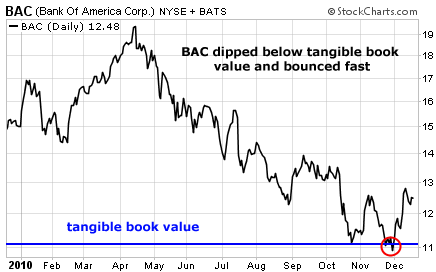
IPFS
How to Trade America's Most Hated Stocks
Written by Sierra Hancock Subject: Economy - Economics USA
How to Trade America's Most Hated Stocks

Editor's note: For more insight and actionable investment advice on the lowest-risk, highest-profit trades in the market, consider a trial subscription to Growth Stock Wire. Click here for details.
I've never seen my readers so angry...
About three months ago, I made one of my most controversial stock recommendations: I told my Penny Stock Specialist subscribers to buy banking giant Citigroup under $4 a share.
As I'm sure you know, America's big banks are still some of the
most reviled companies in the country. And besides that, Citigroup is
far from being a traditional "penny stock." The company's market cap was
about $110 billion at the time of my recommendation.
My readers hated the idea. But I believed the unpopular, under-$10 stock had at least 50% upside.
So far, so good. We're about halfway to my target price. Shares are up over 23%. And the trend looks great.
Here's the thing: It was one of the easiest buys I've made all year.
These days, even the best analysts in the world have trouble
analyzing bank stocks. Assets are still held "off balance sheet." New
regulations are forcing large-cap banks to sell some of their strongest
assets. Also, banks are given flexibility in valuing illiquid mortgages
due to recent changes in market-to-mark accounting. It's a mess.
But my Citibank recommendation couldn't have been simpler. And it's
the safest, best way to trade bank stocks. If you keep this number in
mind, it's easy to trade bank stocks for a quick, one-month, 20% gain. And – when the time is right – you can double, triple, even quadruple your money in two years or less.
Let me explain...
For Citigroup, I saw that revenue and earnings had trended higher
for seven straight quarters. Delinquency rates on loans were declining
each passing month. Also, I knew it was a matter of time before the
Treasury would sell its full stake in Citigroup. With the Treasury no
longer a shareholder, Citigroup could buy back its stock or reinstate
its dividend. And institutions would have more confidence buying the
stock.
All of these were clear positives. But there was an even bigger reason I recommended subscribers buy Citigroup…
We were buying the bank below its tangible book value.
Tangible assets are cash, inventory, buildings... anything that can
be touched. Tangible book value does not include "goodwill" and other
assets that are hard to value. Therefore, tangible book value is a more
accurate reflection of what a company would sell for if it were
liquidated. It's a bargain-basement price.
Right now, the four largest U.S. banks all trade above tangible
book value. In fact, JPMorgan and Wells Fargo are at huge premiums to
their tangible book value. But Citigroup has a tangible book value of
$4.15 a share and a current price of $4.60. The stock could dip back
into "crazy cheap" territory. The same is true of Bank of America
(BAC)...
BAC shares are trading at $12.52. Its tangible book value is
$11.10. So Bank of America is not a buy today. But the large-cap bank
fell below its tangible book value about three weeks ago. Take a look...

As you can see from the chart, Bank of America spiked almost immediately after falling below its tangible book value. This is not a coincidence.
In March 2009, Capital One, SunTrust, and Comerica traded below
tangible book value for the first time in two decades. Even Goldman
Sachs fell below tangible book value in April 2009. These stocks are up
100% to 300% in less than two years.
Tangible book value is one of the best tools I use to analyze
banks. You don't often get the chance to buy banking stocks below this
level. But – as you can see in the case of Citigroup and Bank of America
– this is a great money-making strategy for investing in financials.
Good investing,
Frank Curzio
Editor's note: For more insight and actionable investment advice on the lowest-risk, highest-profit trades in the market, consider a trial subscription to Growth Stock Wire. Click here for details.
Further Reading:
"Customer service ranked near the bottom of every poll taken," Frank
wrote. "In that timeframe, the stock fell from $22 a share to under $2."
But he thinks the company could pop 30% from current prices. Learn more
here: My Favorite Tech Trade Today.
Like Citigroup, another one of Frank's favorite
stocks has stabilized after getting hammered in 2008. This company lost
huge market share to its top competitors...


























